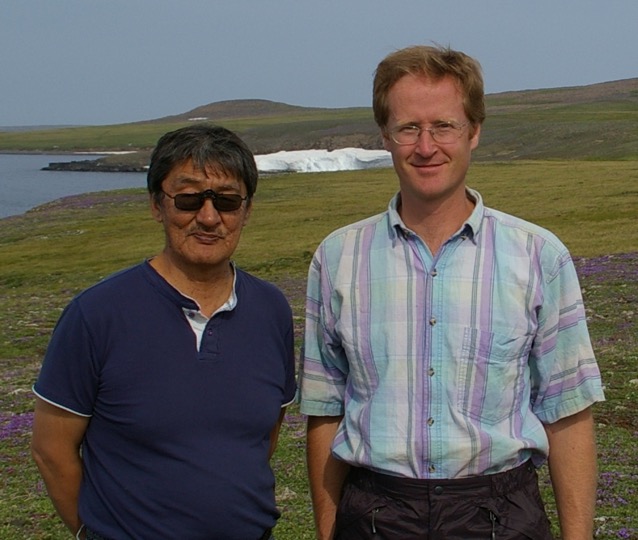
George Noongwook (left), the local project leader, and Henry Huntington (right) out on the land near Savoonga. Photo Credit: Tom Van Pelt
Highlight: “The hunters have a lot of valuable information to share, but often this information is overlooked or regarded as too difficult and time consuming to document. We’re helping show that’s not the case, that there are proven methods for documenting Indigenous knowledge efficiently and sharing that information,” – Dr. Henry Huntington.
This dataset is part of a larger project investigating two related questions – how is the Bering Sea ecosystem changing over time, and what effect do the changes have on the people who live there? To address these questions, research teams visited five coastal communities along the eastern Bering Sea – Akutan, Togiak, St. Paul, Emmonak, and Savoonga. George Noongwook, Dr. Henry Huntington, and colleagues gathered the data for this dataset from hunters in Savoonga, an Alaskan community on St. Lawrence Island in the northern Bering Sea.
The team interviewed St. Lawrence Island Yupik hunters, documenting their knowledge of sea ice and currents, animal locations, locations of dense aggregations of fish, birds or marine mammals, timing of migrations and other annual cycles, and how all of these ecosystem components are changing. Living year-round for generations in places that have seasonal limitations for scientific research vessels, Huntington notes, the St. Lawrence Yupik and other Indigenous peoples in the Arctic have invaluable deep time and seasonal perspectives on ecosystem changes.

George Noongwook (far right) and Henry Huntingdon (second from right) conducting hunter interviews in Savoonga. Photo Credit: Tom Van Pelt
The knowledge shared by the Yupik people of St. Lawrence provides a strong complement to other scientific research exploring ecosystem changes in the Arctic. In fact, Huntington hopes that many of the hunters’ observations can prompt further research questions on topics ranging from marine mammal adaptability to sea ice loss and the causes of seabird die-offs, to how policies either help or hinder the ability of hunters in the Arctic to adjust and adapt to rapid ecosystem changes.
Despite theses changes, Huntington says, the hunters in Savoonga have been adjusting and adapting reasonably well. In their interviews, hunters acknowledged some leaner years, but they continually observe their environment to be ready to take advantage when opportunities arise. The ecosystem changes, however, still make for a more uncertain future in many respects.
In writing papers based on the research in Savoonga, Huntington and his team incorporated data from subsistence harvest surveys, which were collected during a different part of this multi-faceted project. They also used data from other research projects, such as sea ice modelling, to complement the hunters’ narratives. Huntington believes that anyone interested in the Bering Sea and Indigenous knowledge would benefit from this dataset. “Individual projects add incrementally to our knowledge,” says Huntington. “But there are so many projects, it’s hard to keep up with all of them.” So he also hopes that distillations of research findings across disciplines continue to be developed and implemented in the field of arctic research to help Arctic communities and their leaders understand what scientists are learning and address the issues at-hand.
Check out the dataset and learn more about the hunters’ narratives and changes they are experiencing in the Arctic.
Citation: Henry P. Huntington, George Noongwook, Chadwick V. Jay, Bruce G. Marcot, and Caleb Pungowiyi. 2016. Savoonga Field Report for the Local and Traditional Knowledge component of the Bering Sea Integrated Ecosystem Research Program (B69). Arctic Data Center. doi:10.5065/D63J3B30.
By Kathryn Meyer
